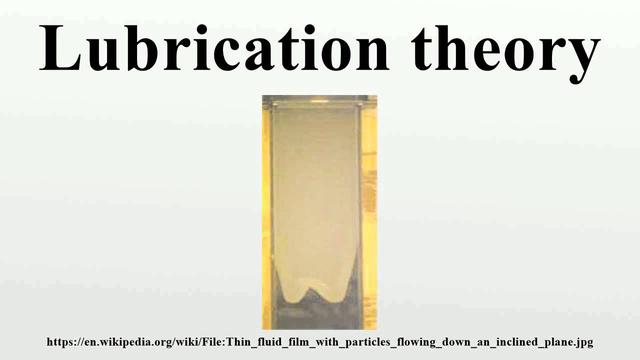Lubrication theory
Introduction
The slit of the bearing and the journal is filled with a viscous lubrication fluid. When the bearing is rotated at a certain speed, the journal is held up by the lubricating film. To form an eccentric ring to prevent the bearing and the journal to avoid direct contact, which reducing the lubrication of frictional resistance. In the lubrication theory, it is usually assumed that the viscous fluid is often motion, and in the laminar flow state, the thickness of the lubricating film is much smaller than its length and width; thorough force and inertial force ignore. Therefore, the lubrication theory belongs to the scope of viscous fluid. According to these assumptions, the fluid mechanics can be simplified to Renault equation:
boundary conditions:
y = 0 u = u v = V, W = W,
y = = 0, V = 0, W = 0,
U, V, W are flow rate components along the X, Y, Z coordinate axes, respectively; U, V , W is the boundary value of the flow rate component; p is fluid pressure; ρ is a fluid density; μ is the power viscosity coefficient of fluid (see adhesive); H is the thickness of the lubrication film (Fig. 1). This equation is the basic equation of lubrication theory. Formula (1) is divalent, two-dimensional, variable coefficient, non-homogeneous partial differential equation, generally difficult to solve, usually using an approximation method.
Several main types of lubrication
Oil film taking slip
Lubrication of the oil film as a lubricant. Lubricants are generally uncomfortable, only one direction movement (u = u, υ = 0, ω = 0), so equation (1) can be simplified as common type
Figure 2 Lubrication diagram for radial bearing. In the figure, o is the center of the journal; E is the bearing center; E is the eccentric distance OO '; R, R is the journal radius, the inner radius of the bearing; H is the thickness of the lubrication film; u is the line speed of the journal surface; θ is the extreme angle. This type of lubrication problem can be chemically formulated as the following formula:
according to Figure 3, the boundary condition is: x = 0, P = 0; x = L, P = 0 (5). From the equation (4), (5), the pressure distribution P, the total support P and the frictional resistance f:

of the unit width block interface can be affected on the unit width lubricating film. The meaning of the symbol is shown in Figure 3.. As can be seen from the pressure distribution curve of Figure 3, the position of the maximum pressure P max is not in the slider, and at the midpoint bias. | F | / | p | Posaged to small amounts h 0 / l , that is, the viscous fluid motion in the thin layer of thickness can produce a supporting force greater than total grinding . A high pressure is a significant feature of lubricating flow in a slow thin layer viscous flow.
assumes that the motion is one-dimensional in the above calculation. In fact, the size of the bearing in the z direction is limited, that is, the end of the end. Since the pressure is reduced in the Z direction, people find that the support is significantly reduced than two dimensions. Second, in the calculation, it is assumed that the viscosity coefficient is constant, which is obviously an approximation. Due to frictional heat, the temperature of the lubricating oil will rise, thereby causing the viscosity of the oil and the sharp decline. As the high-speed and high temperature (low viscosity), the inertial force becomes possible and the viscous force, and the effort to completely illegibility must be corrected. It can be improved by successive approximation. Calculations show that inertial corrections generally do not exceed 10%. For two-dimensional flow and two eccentric cylinders, the viscous fluid motion of the two eccentric cylinders, is required to decompose (2) and (3).
Gasplage Lubrication
The lubricant of lubricant is lubricant with gas film such as air. This lubrication must consider the compression effect. The pressure and density of the gas meets the multi-process equation:
Usually the gas film lubrication can be regarded as the waiting process, namely n = 1, so it is obtained:
Even in the simplest case, the Renault equation that the gas film lubricates is also complex, and it is generally necessary to solve the numerical method.
The various forms of the above Renault equations are only applicable to the low speed zone. If the inertial force and the viscosity are the same order, it is difficult to obtain the precise solution of this equation due to the nonlinear item in the moving differential equation. If the inertial force is smaller in total fluid power, an approximate method such as iterative method, average inertia, and a stage expansion method can be used.
For shear flow, the laminar flow of the experiment is transformed into a critical Renault number of turbulence
The flow state is changed to turbulence, and must be solved according to the turbulence theory. The study of turbulent lubrication begins later. Calculation methods for existing turbulence lubrication are generally "0" equation mode and "1" equation mode. For non-compressible quasi-constant two-dimensional flavoring, the basic equation is:
Pˉ is average pressure, k x k z is a turbulent stream coefficient. The turbulent lubrication equation is similar to the above Renault equation. In the engineering calculation, the turbulence coefficient is also different from the turbulence mode. If the turbulence mode is built on the wall-rhythm basis, the
Elastic fluid power lubrication
has a changeable coefficient Lubricating film and elastic deformation contact surface lubrication. For example, the gear is engaged with the lubrication between the ball bearings and the inner, and the outer ring. Their common feature is that the load acts on a tiny contact area, thereby forming a high pressure region, thereby changing the viscosity coefficient of the lubricant, elastically deforming in the contact surface. The study of such elastomeric fluid lubrication problems, attributed to the connection of lifting solution, elastic deformation equation, and viscous-pressure equation. If the remaining conditions are no longer valid, consider lubricating energy equations and thermal conducting equations. In addition, it is necessary to apply a border condition of the air hole. The formula of the simplified semi-experienced half theory is commonly used in engineering calculations.
Fluid Static Lubrication
The two interfaces of the lubricating membrane have no relatively tangential movement. The above basic lubrication classes are allocate fluid power lubrication range. For such lubrication problems, the necessary conditions established by the lubricating film are that the two interfaces must have relatively tangential motion, and the film thickness must converge. However, for fluid static lubrication problems, since the establishment of the lubricating film is only dependent on the pressure difference, only the pressure on the side is higher than the pressure on the other boundary. For two-dimensional static lubrication, the Renault equation can be simplified to the Laplas equation:
This kind of lubrication problem is also relatively simple. (For example, the hole is rarely occurs), and therefore, numerical solution is generally obtained for commonly used lubricants.
In addition to the above types of lubrication, in the working environment of high temperature and liquid metal, the reactor and the nuclear power turbine generator, some people have been studied using magnetorescent lubrication to improve liquid metal by external electromagnetic fields. Lubricating the load capacity of the slide. The Lorenz force is generated by the induction current, current and magnetic field interaction due to the magnetic field, and the direction of this force is consistent with the direction of the viscous force, thereby improving the load carrying capacity.应 应.......................... "China Encyclopedia" 74 volume (first edition) mechanics entry: fluid mechanics China University of International Publishing House, 1987: 413-414 Page
o. Pink S, b. Self Dynasty Li Xi, Xi'an Jiaotong University Bearing Research Association: "Fluid Power Lubrication Theory", Institutional Industry Press, Beijing, 1980. (O. PIN-KUS AND B. Sternlicht, Theory of Hydrodynamic Lubrica-Tion, McGraw-Hill, New York, 1961.)
Latest: Fred Smith







